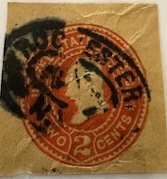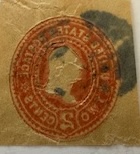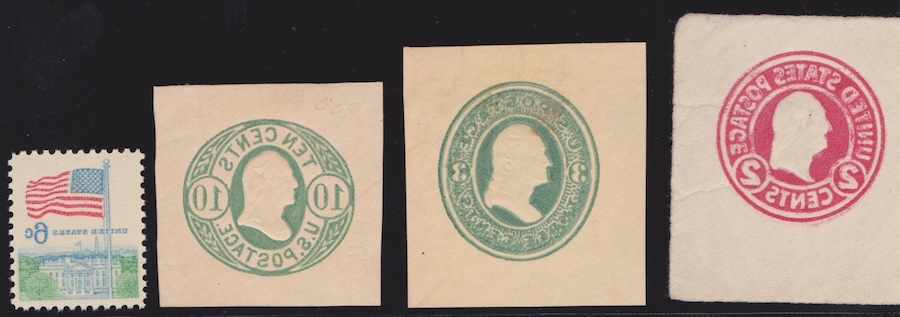| Author |
 Replies: 12 / Views: 387 Replies: 12 / Views: 387 |
|
|
New Member
United States
3 Posts |
|
|
I have never seen this variation and can not find any info on it. Any information would be helpful.   |
|
Send note to Staff
|
|
|
|
|
Bedrock Of The Community
11509 Posts |
|
|
I am far from a stationary expert, but the only logical explanation is that the ink came through to the back. The cancellation ink did as well to an extent so the paper must have been quite absorbent. Is there something I am missing? |
Send note to Staff 
|
|
|
New Member
United States
3 Posts |
|
|
I don't know. Could be. The image is very crisp for the ink to have bleeded thru. |
Send note to Staff 
|
|
|
Bedrock Of The Community
11509 Posts |
|
|
I understand what you are saying but ask yourself "how could the image be printed in reverse"? It could not be. It is not possible. |
Send note to Staff 
|
|
|
Pillar Of The Community
United States
6831 Posts |
|
|
I've read of a set-off reversed impression created when the press cycles without a piece of paper, essentially printing the design on the platen. The next piece of paper through the press picks up that ink from the platen and ends up being printed front and back, at the same time.
Not saying that is what happened here, but that is a potential explanation for a reversed impression on the back? |
Send note to Staff 
|
|
|
New Member
United States
3 Posts |
|
|
Pillar Of The Community
United States
6831 Posts |
|
|
I don't know about value. EFO collectors seem to like things that "pop." Does this one have that quality? If you mounted it with the back facing out, it's a conversation piece, for sure.
For me, if it was in a dealer's $2 box, I might grab it. If it was in the $5 box, I'd think, "Interesting" and move past it. If it was a King George V item, I might pay $5, and think twice at $10?
Others may have wildly different ideas of value. It's why art, stamps, etc., are auctioned. |
Send note to Staff 
|
|
|
Bedrock Of The Community
11509 Posts |
|
|
My two cents: If a genuinely reverse printed example of this existed, I would think that it would be in a specialized catalog by now or there would be auction records. I can find none but maybe a postal stationery expert will weigh in. I believe, as I said above, that the ink soaked through just as the cancellation ink did. So, given that it is a badly wrinkled cut square of a common issue the value lies in being a curiosity for collectors. Hard to place a value on it but I can't imagine more than a couple of dollars at most, if that. I hope someone comes along and says otherwise for your financial sake.  |
Send note to Staff 
|
|
|
Pillar Of The Community
6060 Posts |
|
|
There are two fairly-often encountered printing EFO's with these stamped envelopes: Both related and easy to explain as feed glitches.
1. Printed on both sides. The result of Cjd's explanation just provided. A cycling of the press without paper thus inking the back side of the die, then the next sheet through gets inked on both sides.
2. Albino, with no ink. The result of a double-feed. The extra sheet gets embossed, but not inked. |
Send note to Staff 
|
|
|
Pillar Of The Community

United States
705 Posts |
|
|
I agree with Cjd that this is an inking offset/setoff. Here are a few of mine.  A couple of dollars is about right for a common one, depending on condition. Maybe more if it is especially clean and crisp, or a better catalog number. I quibble with John though about the term "printed on both sides". I would use that term only for pieces where the same sheet of paper went through the printer twice, the second time upside down, and were truly printed on both sides, versus these set-offs which are a mirror-image impression caused by picking up excess ink from the platen or sometimes, after stacking, wet ink picked up from the sheet below. |
Send note to Staff 
|
|
|
Pillar Of The Community
6060 Posts |
|
|
ZebraMan,
Point taken as I am often a stickler for exacting definitions, which the hobby often uses sloppily. In this case, I tried to keep it simple (and sloppy?) and used "Printed on both sides" and "Albino" as quick title desciptions of the two different but related results and then added the feeding details to further clarify. Both should be taken together.
General comment. More broadly, in the age of Twitter, many posts like my first reply here are often quite short to get the gist of the idea across rather than flowery paragraphs describing every minute detail or scenario. I recently had an excellent exchange with another member here about various posts and how their wording and tone can create impressions, etc. But this is all an unrelated tangent. |
Send note to Staff 
|
| Edited by John Becker - 01/28/2025 8:41 pm |
|
|
Pillar Of The Community
United States
3822 Posts |
|
|
Pillar Of The Community
United States
1722 Posts |
|
|
I believe Zebraman has offered the most likely cause: an offset ink transfer. Generally, offsets that result from stacking have a more smudged appearance, so excess ink from the platen seems the best explanation for those illustrated here. |
Send note to Staff 
|
|
| |
 Replies: 12 / Views: 387 Replies: 12 / Views: 387 |
|
